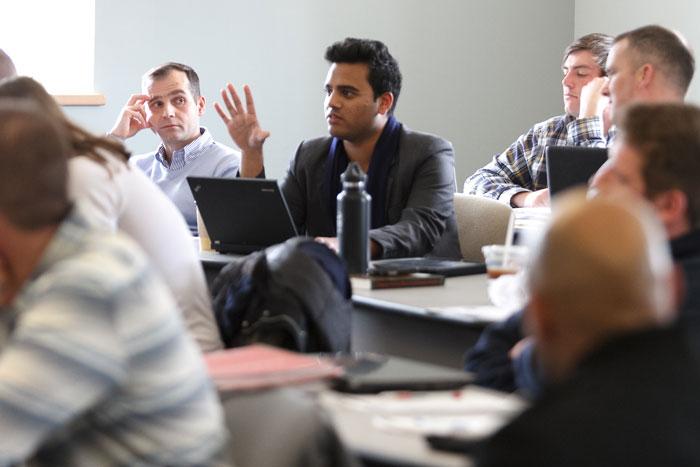The Great War and How to Teach It

Prateek Allapur '15 (international studies) makes a point. Photo by Carl Socolow '77.
Dickinson students and War College fellows find common ground in WWI course
by Tony Moore
Before World War I, history had never seen anything quite like it. And there’s never been anything like How the Great War Made America Modern, an interdisciplinary course whose uniqueness echoes that of the conflict at its core.
Made up of a blended class of Dickinson students and U.S. Army War College fellows—liberal-arts undergrads, among them two members of ROTC, and members of the military with decades of experience—the course tackles WWI and the long shadow it has cast over the history of the United States.
And it offers distinct opportunities for both classroom contingents.
“These two groups, despite their very different life experiences, have a lot to say to one another, and a lot to learn from one another,” says Wendy Moffat, professor of English and one of the course’s instructors. Moffat notes that a divide exists between what contemporary students know about war and what military figures can impart about the experience, and it’s a divide that can be bridged, in part, in the classroom.
“Our aim is to facilitate an exchange through a shared intellectual quest that unearths the past even as it illuminates the present,” says Moffat of her shared mission with co-instructor Tami Biddle, professor of military history and national security strategy at the War College.
A complex lens
Stemming from a wide-reaching Mellon Foundation grant awarded to Dickinson to reduce that civilian-military gap, the course approaches the divide in interconnected ways—chiefly by creating an open forum for students inhabiting very different worlds and creating new networks among civilian and military academic colleagues, with WWI as the leaping-off point.
“I have been interested in military history and strategy for some time now, and the exploration of that subject matter probably has been my favorite part,” says Tristan Arnold ’18 (international studies), who says Dickinson’s proximity to the War College, and the opportunities that might emerge because of it, helped him decide to attend Dickinson. “That's not to diminish the social, historical, historiographical or other portions of the class in any way. The whole thing is unique and extremely valuable.”
With today’s complicated and tense global stage—including situations in Ukraine and Iran and the rising threat of ISIS—Biddle thinks the timing is right.
"I have been concerned for a long time that our general population doesn't really know very much about the military," says Biddle, an internationally known expert on air power in WWI. “When we send soldiers off to war, we are making a very important political choice. We are also engaging our own blood and treasure, and we better think hard about it."
The modern struggle with that issue was born in WWI, and the class looks through that lens in both directions, exploring issues such as how the war shaped the U.S. and its role in the world, and how that role and its consequences have carried over to places such as Iraq and Afghanistan.
Crossing the divide
The value of the class is born of more than just the material being taught, as students from both ends of the spectrum have found that simply being in the room with students from another, very different, institution has made it a fuller experience.
“I have really enjoyed the interactions,” says Col. Mark Baxter, a 27-year veteran of the U.S. Army who has two college-age sons. “The Dickinson students are more mature than I was at their age and well educated. They're idealistic but have open minds, and I've been most impressed with their willingness and ability to express their opinions.”
Dickinson’s Emma Jane Beckert ’17 (history) has been absorbing the swirl of opinions, also from another standpoint.
“I’m an Army brat, so it’s like taking a class with my dad,” she says, noting that all the experience she sees in the room with the War College fellows doesn’t intimidate but rather enlightens her. “Our perspective in a liberal-arts institution is much different from theirs. I have a good understanding of both because of my dad, but I love hearing what they pick up in the reading juxtaposed with the Dickinson students’ opinions.”
For Col. Curt Simonson, who also has served as an officer in the U.S. Army for 27 years, the course has provided a view across the divide and shed light on both the past and the future.
“I am a big believer in the importance of civil-military relations, and this course provides an excellent opportunity to interact with a group of very talented young men and women,” he says. “Anyone who is worried about the future of American leadership should spend a few days at Dickinson; they will find the future is in good hands.”
Learn More
- Department of English
- Department of History
- Department of International Studies
- U.S. Army War College
- Moffat receives prestigious fellowship: "The Best of the Best"
- Clark Forum panelists discuss the Great War: "Causes and Consequences"
- Latest News
Published April 28, 2015